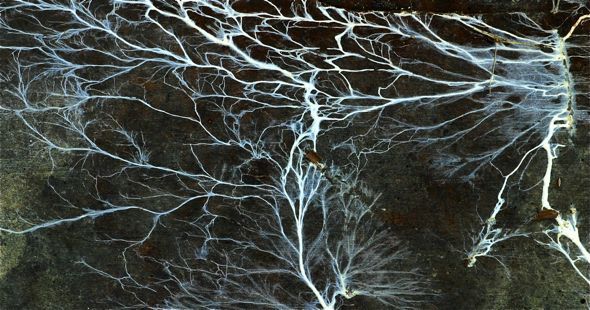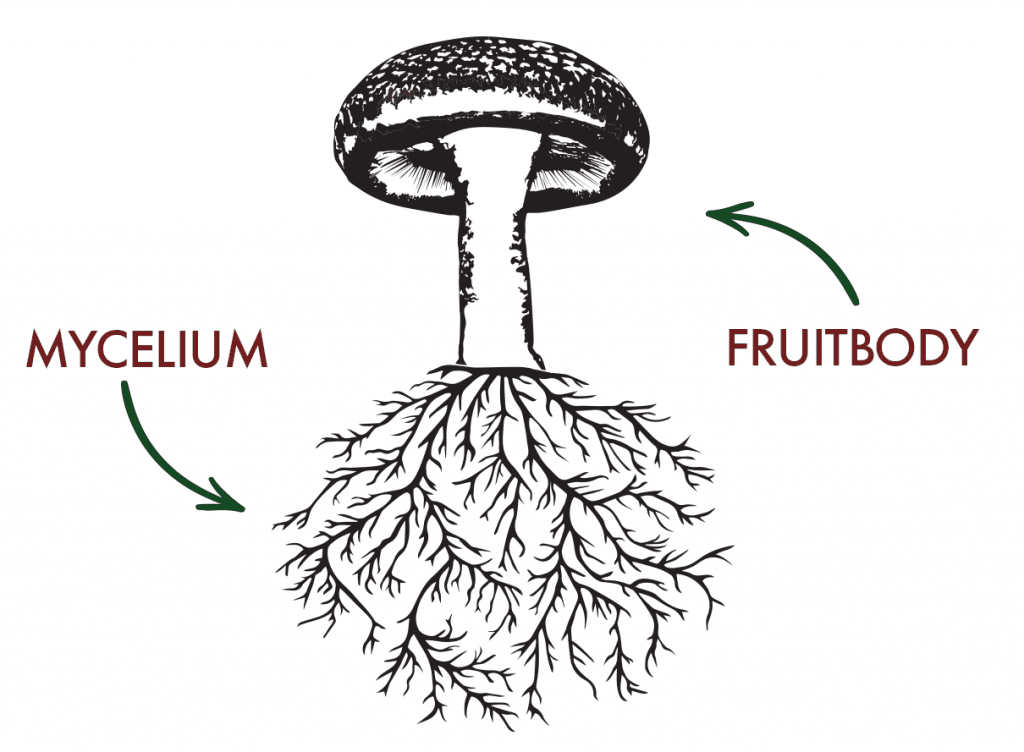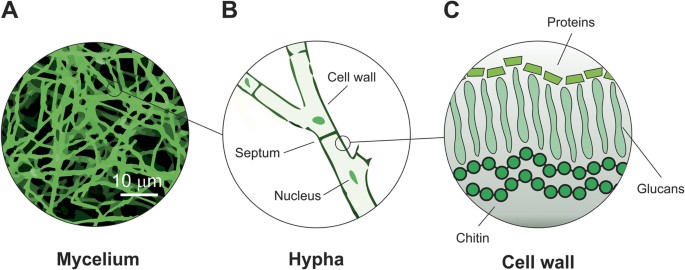
Mushrooms are a type of fungal organism with a three-stage life cycle that is similar to the different stages found in plants. Mycelium is the longest living part of the organism. It consists of myriad intricate filaments that are only one cell-wall thick. Despite its delicate stature, mycelium is quite formidable. It grows for months, years, potentially centuries, and navigates through a sometimes inhospitable ecosystem. It is capable of expanding its reach through a habitat filled with millions of microbes while communicating chemically with the surrounding environment, devising complex chemical responses to whatever challenges it encounters.Eventually, when the circumstances are favorable, mushroom mycelium generates a fruit body – the above-the-surface, easily identifiable part of the mushroom organism. The process of producing a mushroom fruiting body requires that the mycelium maintain a highly active immune response to prevent pathogens from harming it. Meanwhile, the mushroom fruit bodies that eventually form, much like many flowers or fruits, can be highly perishable. For example, the oyster mushroom rots in just a few days. This is in stark contrast to the mycelium that generated it which can live for months, years, or decades.
Mycelium consists of thousands of delicate, interwoven filaments, just one cell-wall thick, with highly active cells that serve many important functions, including acting as the immune response of the fungal organism. While spores exist to sprout mycelium, and fruit bodies come and go for reproductive purposes, mycelium represents the primary ‘body’ stage of existence in the fungal organism’s life cycle.

The benefits of mushroom superfoods extend much farther from just the beta-glucans. The myriad of complex polysaccharides, polyphenols, vitamins, minerals, prebiotics and digestive enzymes within the mycelium are essential pieces of the way functional mushrooms interact with our own systems. Just as mycelium play a key role to the health of the ecosystems around them, so too do they play a role in our own health.
Because of the delicate, filament-like appearance of the mycelium, people sometimes assume it is nothing more than a root system designed to support a fruiting body. While it’s easy to dismiss the vast network of mycelial filaments under the surface, it’s important to understand that the mycelium represents the primary function of the organism.
- Mycelium is the highly dynamic stage of the mushroom life cycle. Mycelium is the primary “plant” portion of the mushroom, while the fruit body is the temporary “flowering” part of the mushroom life cycle that releases spores for reproduction.
- Mycelium is the longest living part of the organism. Depending upon the species, mycelium can remain highly dynamic and metabolically active for ~95% of the overall life cycle, while fruiting bodies often represent less than 5% of the life cycle timeline.
- Mycelium serves as the immune response that supports not only the health, vitality, and immune response of the fungal organism, but also supports the health of the surrounding ecosystem. Scientific research, targeted studies, and widespread use in holistic treatment plans demonstrate that when harnessed in the form of supplements, human beings also benefit from the significant health-supporting power of mushroom mycelium.

Mycelium is kind of like yeast (both are fungi), but unlike most yeast cells, which grow as a single cell, mycelium is multicellular and can grow into macro-size structures—which we most often recognize as mushrooms. Not only does mycelium produce small molecules, but it gently and with supreme precision assembles them into complex structures so small that they are invisible to the human eye.
Working much like single-celled yeast, mycelium takes in small molecules of food—typically sugar but often from sources such as wood or plant waste—by excreting enzymes that break these materials down into digestible morsels. As the mycelium grows it assembles a dense network of long, microscopic fibers that grow through the substrate like a superhighway system.
Once the mycelium has fully built its network, it transitions to its next stage: building a mushroom. This is where humans can intervene. Rather than letting a mushroom pop up out of the substrate, the mycelium can be coaxed to build predictable structures by controlling temperature, CO2, humidity and airflow to influence the growth of tissue. This is a rapid process: the accumulation of fibers becomes a visible speck after a few hours, a visible sheet after a day or two, and an 18-by-2-by-12-inch sheet weighing a couple of pounds within the course of a week.

Directing the growth of mushroom fibers may not sound like a big deal, but this evolution in biofabrication stands to transform the way we manufacture, consume and live. What are the possibilities? Mycelium’s fast-growing fibers produce materials used for packaging, clothing, food and construction—everything from leather to plant-based steak to scaffolding for growing organs. Mycelium, when harnessed as a technology, helps replace plastics that are rapidly accumulating in the environment.
Mycelium also provides a cruelty-free way to create meatlike structures with a much smaller environmental footprint than traditional livestock, reducing greenhouse gas emissions, the use of food crops for feed and land use conversion. All these benefits come with little environmental cost: the process of growing mycelium results in limited waste (mostly compostable) and requires minimal energy consumption.
While the fruiting body of the mushroom is important and can provide benefits of its own, the mushroom mycelium health benefits typically focus on the immune system. Mycelium is best known for helping to maintain healthy immune function by supporting immune cells for protection, immune strength and a balanced immune response.
“Without fungi to aid in decomposition, all life in the forest would soon be buried under a mountain of dead plant matter”. After consuming things that are no longer alive and acting as decomposers, they essentially create new life.






